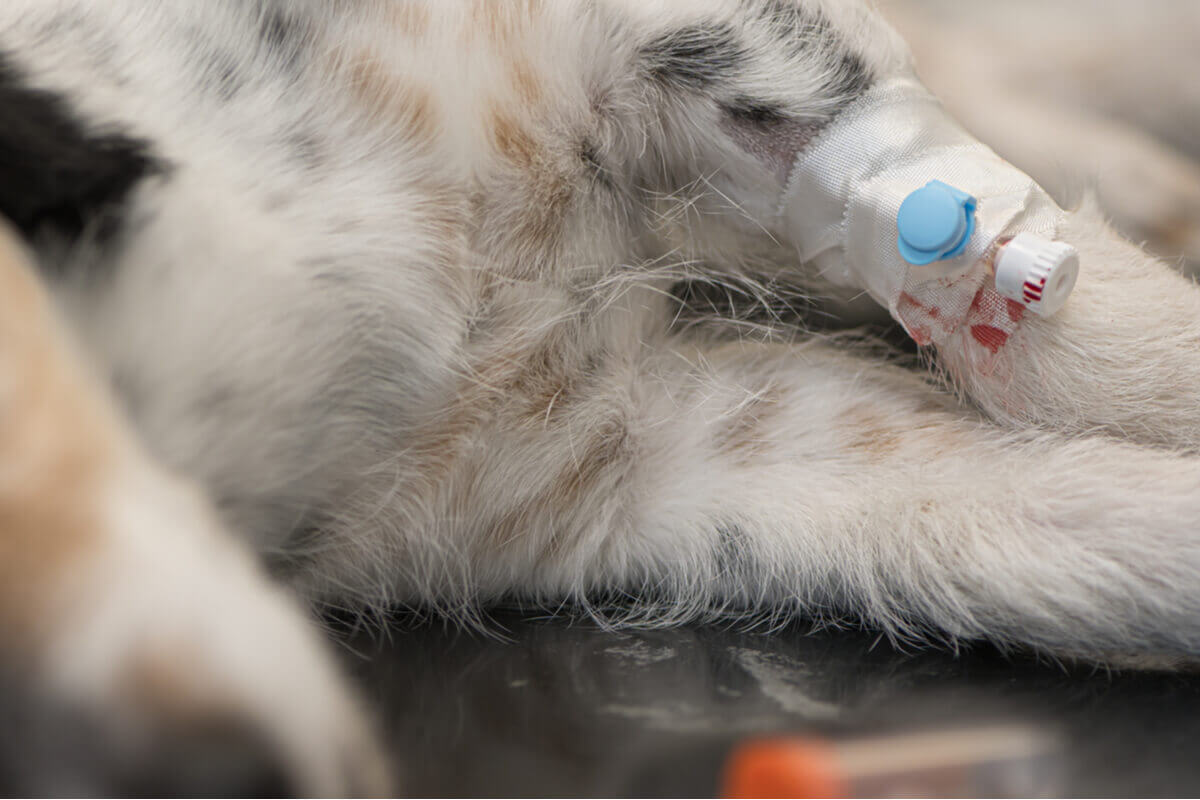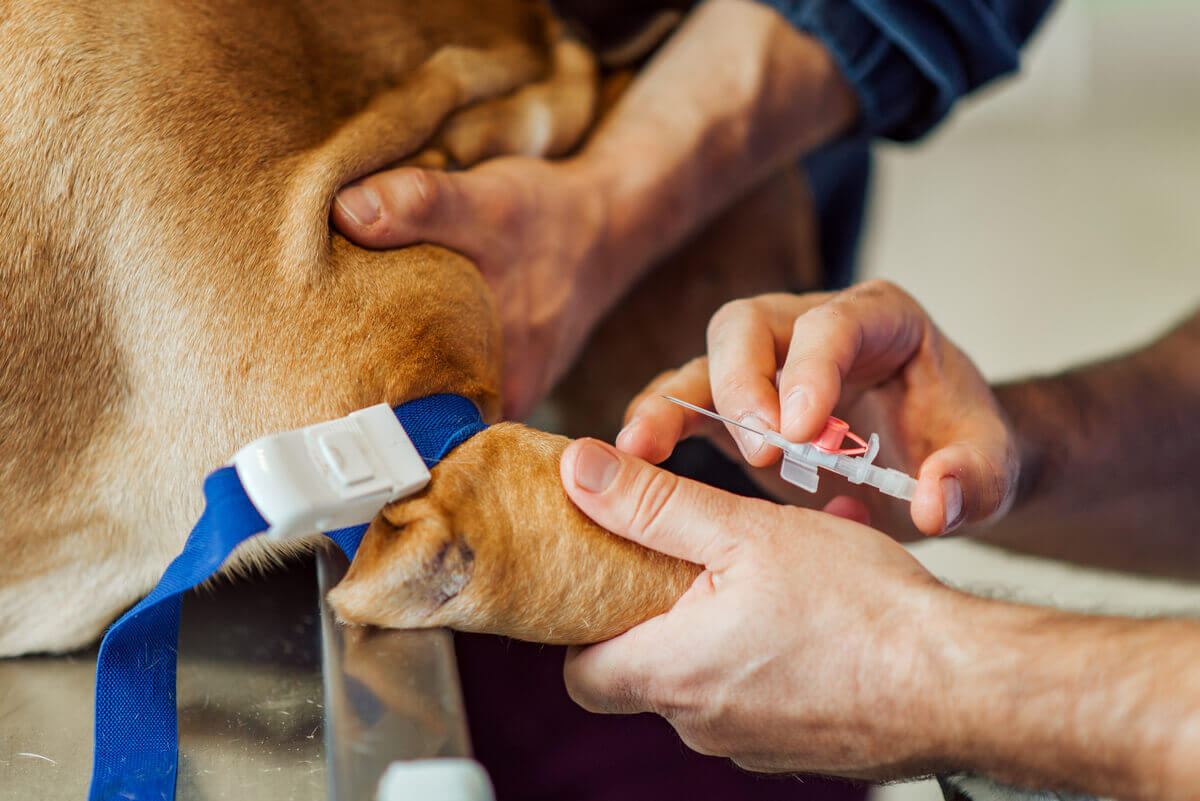Intravenous Therapy in Pets and Possible Complications


Written and verified by the vet Érica Terrón González
Administering intravenous therapy in pets consists of inserting a tube – catheter – into a vein and, through it, providing liquid mediation. This allows the drug to reach the bloodstream directly and take effect more quickly than through other routes. Intravenous therapy in pets is a fundamental practice in veterinary medicine.
Placing and maintaining intravascular access requires skill on the part of the practitioner. This activity can be crucial for the delivery of critical care in an emergency room or for administering anesthesia prior to surgery. Therefore, staying informed and up to date about its characteristics and complications is essential.
Intravenous therapy in pets: Access
To choose the optimal intravenous access for each patient, there are several factors to take into consideration. Among them, we find the following:
- First, the professional must choose the vein. This is because the choice of one vein over the other depends on the species, the size of the animal, and its behavior -among other things.
- Second, the choice of the catheter.
- And third, the ease of insertion and maintenance.
It’s also essential to take the animal’s temperament into account when choosing this type of therapy. Aggressive pets can be difficult to handle. Professionals must also consider the presence of various disorders in the animal, such as coagulation problems or regional vascular obstruction.

Insertion of the catheter
Now we’ll describe the various options for placing an intravenous catheter in pets.
Accessibility of peripheral veins
Peripheral veins are those located “far” from the vena cava. They’re the usual choice for the administration of almost any fluid and medication. In fact, it should be the site of choice for emergency intravenous access in patients – as long as there’s no reason against it.
Peripheral veins of choice in pets are as follows:
- In the case of dogs, the cephalic vein – in the front legs – and the saphenous vein or femoral vein – both in the hind legs – are the most common. When it comes to breeds with large ears, doctors can also choose the auricular veins.
- With cats, the cephalic vein or the femoral vein are the main choices.
- For exotic pets, the choice is usually more complex. In rabbits, for example, it’s possible to use the auricular veins as well as the saphenous vein and the cephalic vein, as in ferrets. However, in pet birds, due to their size, peripheral access is usually complicated.
Central veins
The jugular vein in the neck is the most common site for central catheter placement, easily accessible to most patients. However, sometimes reaching the jugular vein isn’t possible for safety reasons.
In those cases, if central intravenous access is essential, resorting to placing a central catheter is possible, but with peripheral insertion. In other words, the professional inserts a long catheter through a peripheral vein of the type we mentioned in the previous section to reach the vena cava.
Intravenous therapy in pets: Complications
Like any other therapy, catheter placement and maintenance can involve more or less serious complications. This will be detrimental to the health of the animal or to the effectiveness of the treatment administered. In the following paragraphs, we’ll show you the most common mishaps.
Displacement of the catheter with the consequent loss of medicinal fluid
Even if the instructions have been strictly followed when placing a catheter and securing it, there’s a risk that it may become displaced. Animals move around and the line eventually makes them uncomfortable.
The risk of displacement is usually greater with the use of peripheral catheters because it’s easier for the animal to access them.
Carefully holding and protecting the pet in the clinic are the best strategies for limiting catheter migration and fluid loss. However, the only thing that’s truly useful is to keep the animal under surveillance.
Vascular inflammation and thrombus formation
Any pet that has a line placed is at risk of phlebitis – vascular inflammation – or thrombophlebitis – inflammation due to the presence of a clot. This is due to the inherent endothelial damage and inflammation incited by the presence of a foreign body – the catheter itself – in the vein.
When the origin of the inflammation is an infection, the problem becomes really serious. Because, in that case, the fluid administration itself will act as a vehicle for the transmission of the bacteria through the blood to the rest of the body.
For this reason, the catheters must be checked regularly. If any redness, swelling, pain, and/or firmness is identified, immediate removal will be considered. Complications can progress, and what starts out as phlebitis can lead to endocarditis.
Thrombosis and thromboembolism, two common complications of intervenous therapy in pets
Blood clots can form inside the catheter, especially when fluid administration isn’t constant. This obstructs the flow and, at the same time, releases thrombi into the bloodstream. In animals who have a greater predisposition for clot formation, it’s best to take this factor into account.

As you may have observed, there are multiple guidelines and complications to keep in mind when using intravenous therapy in pets. Although there are inherent risks, sometimes this is the only possible option in the veterinary clinic.
Administering intravenous therapy in pets consists of inserting a tube – catheter – into a vein and, through it, providing liquid mediation. This allows the drug to reach the bloodstream directly and take effect more quickly than through other routes. Intravenous therapy in pets is a fundamental practice in veterinary medicine.
Placing and maintaining intravascular access requires skill on the part of the practitioner. This activity can be crucial for the delivery of critical care in an emergency room or for administering anesthesia prior to surgery. Therefore, staying informed and up to date about its characteristics and complications is essential.
Intravenous therapy in pets: Access
To choose the optimal intravenous access for each patient, there are several factors to take into consideration. Among them, we find the following:
- First, the professional must choose the vein. This is because the choice of one vein over the other depends on the species, the size of the animal, and its behavior -among other things.
- Second, the choice of the catheter.
- And third, the ease of insertion and maintenance.
It’s also essential to take the animal’s temperament into account when choosing this type of therapy. Aggressive pets can be difficult to handle. Professionals must also consider the presence of various disorders in the animal, such as coagulation problems or regional vascular obstruction.

Insertion of the catheter
Now we’ll describe the various options for placing an intravenous catheter in pets.
Accessibility of peripheral veins
Peripheral veins are those located “far” from the vena cava. They’re the usual choice for the administration of almost any fluid and medication. In fact, it should be the site of choice for emergency intravenous access in patients – as long as there’s no reason against it.
Peripheral veins of choice in pets are as follows:
- In the case of dogs, the cephalic vein – in the front legs – and the saphenous vein or femoral vein – both in the hind legs – are the most common. When it comes to breeds with large ears, doctors can also choose the auricular veins.
- With cats, the cephalic vein or the femoral vein are the main choices.
- For exotic pets, the choice is usually more complex. In rabbits, for example, it’s possible to use the auricular veins as well as the saphenous vein and the cephalic vein, as in ferrets. However, in pet birds, due to their size, peripheral access is usually complicated.
Central veins
The jugular vein in the neck is the most common site for central catheter placement, easily accessible to most patients. However, sometimes reaching the jugular vein isn’t possible for safety reasons.
In those cases, if central intravenous access is essential, resorting to placing a central catheter is possible, but with peripheral insertion. In other words, the professional inserts a long catheter through a peripheral vein of the type we mentioned in the previous section to reach the vena cava.
Intravenous therapy in pets: Complications
Like any other therapy, catheter placement and maintenance can involve more or less serious complications. This will be detrimental to the health of the animal or to the effectiveness of the treatment administered. In the following paragraphs, we’ll show you the most common mishaps.
Displacement of the catheter with the consequent loss of medicinal fluid
Even if the instructions have been strictly followed when placing a catheter and securing it, there’s a risk that it may become displaced. Animals move around and the line eventually makes them uncomfortable.
The risk of displacement is usually greater with the use of peripheral catheters because it’s easier for the animal to access them.
Carefully holding and protecting the pet in the clinic are the best strategies for limiting catheter migration and fluid loss. However, the only thing that’s truly useful is to keep the animal under surveillance.
Vascular inflammation and thrombus formation
Any pet that has a line placed is at risk of phlebitis – vascular inflammation – or thrombophlebitis – inflammation due to the presence of a clot. This is due to the inherent endothelial damage and inflammation incited by the presence of a foreign body – the catheter itself – in the vein.
When the origin of the inflammation is an infection, the problem becomes really serious. Because, in that case, the fluid administration itself will act as a vehicle for the transmission of the bacteria through the blood to the rest of the body.
For this reason, the catheters must be checked regularly. If any redness, swelling, pain, and/or firmness is identified, immediate removal will be considered. Complications can progress, and what starts out as phlebitis can lead to endocarditis.
Thrombosis and thromboembolism, two common complications of intervenous therapy in pets
Blood clots can form inside the catheter, especially when fluid administration isn’t constant. This obstructs the flow and, at the same time, releases thrombi into the bloodstream. In animals who have a greater predisposition for clot formation, it’s best to take this factor into account.

As you may have observed, there are multiple guidelines and complications to keep in mind when using intravenous therapy in pets. Although there are inherent risks, sometimes this is the only possible option in the veterinary clinic.
All cited sources were thoroughly reviewed by our team to ensure their quality, reliability, currency, and validity. The bibliography of this article was considered reliable and of academic or scientific accuracy.
- Terapia intravenosa [Internet]. Es.wikipedia.org. [cited 20 October 2020]. Available from: https://es.wikipedia.org/wiki/Terapia_intravenosa#:~:text=La%20terapia%20intravenosa%20o%20terapia,para%20suministrar%20l%C3%ADquidos%20y%20medicamentos.
- Endotelio [Internet]. Es.wikipedia.org. [cited 20 October 2020]. Available from: https://es.wikipedia.org/wiki/Endotelio#:~:text=El%20endotelio%20es%20un%20tejido,intercambio%20de%20nutrientes%20y%20desechos.
- Endocarditis [Internet]. Es.wikipedia.org. [cited 20 October 2020]. Available from: https://es.wikipedia.org/wiki/Endocarditis
- King L, Boag A. BSAVA Manual of Canine and Feline Emergency and Critical Care. 2nd ed. 2007.
This text is provided for informational purposes only and does not replace consultation with a professional. If in doubt, consult your specialist.








